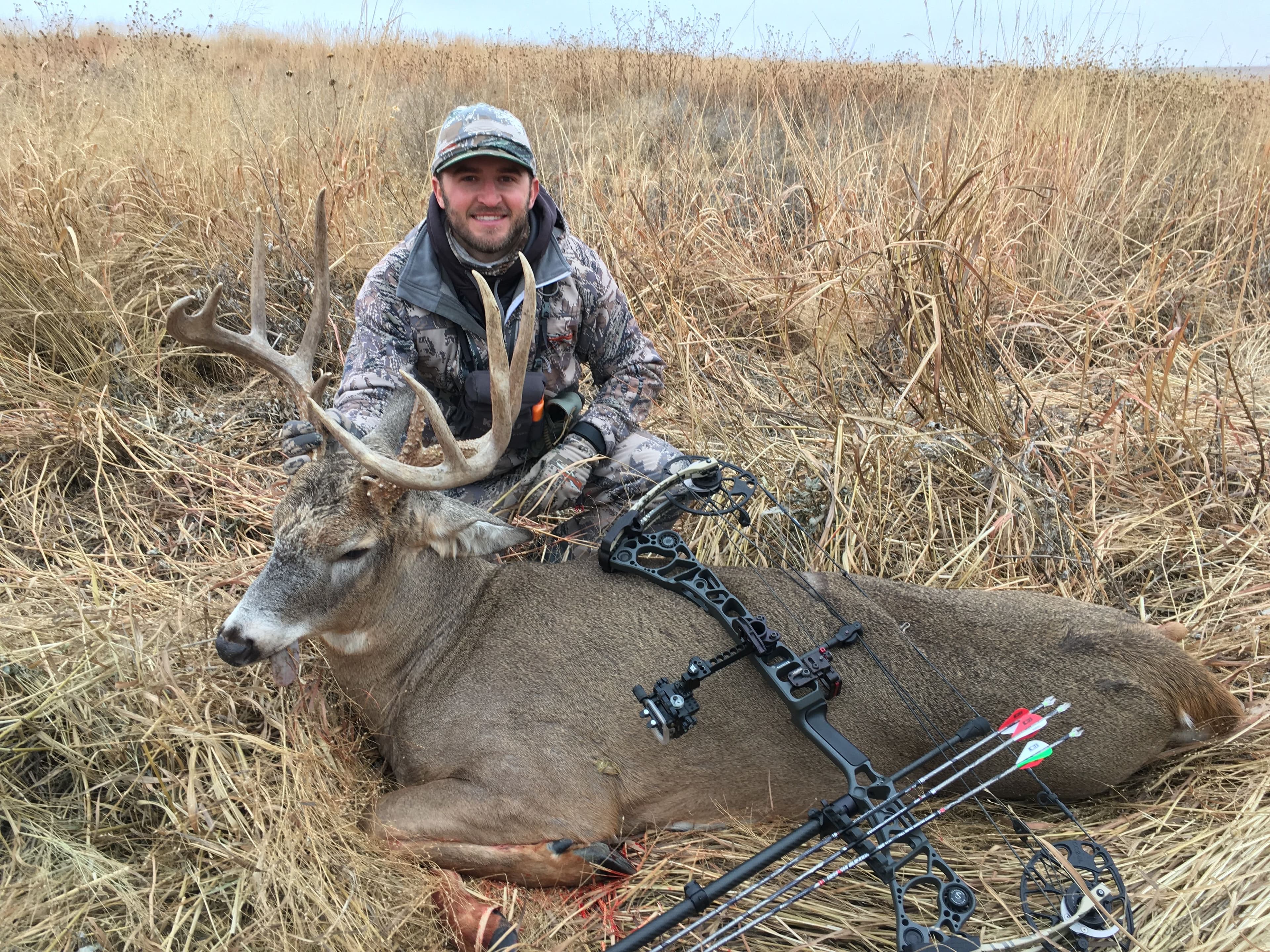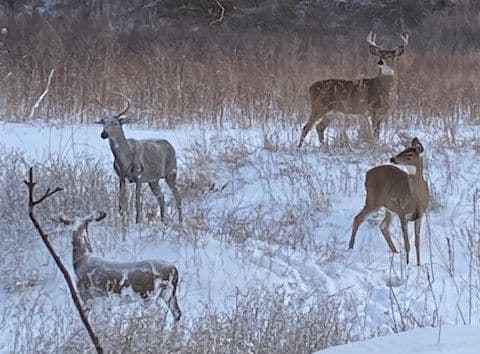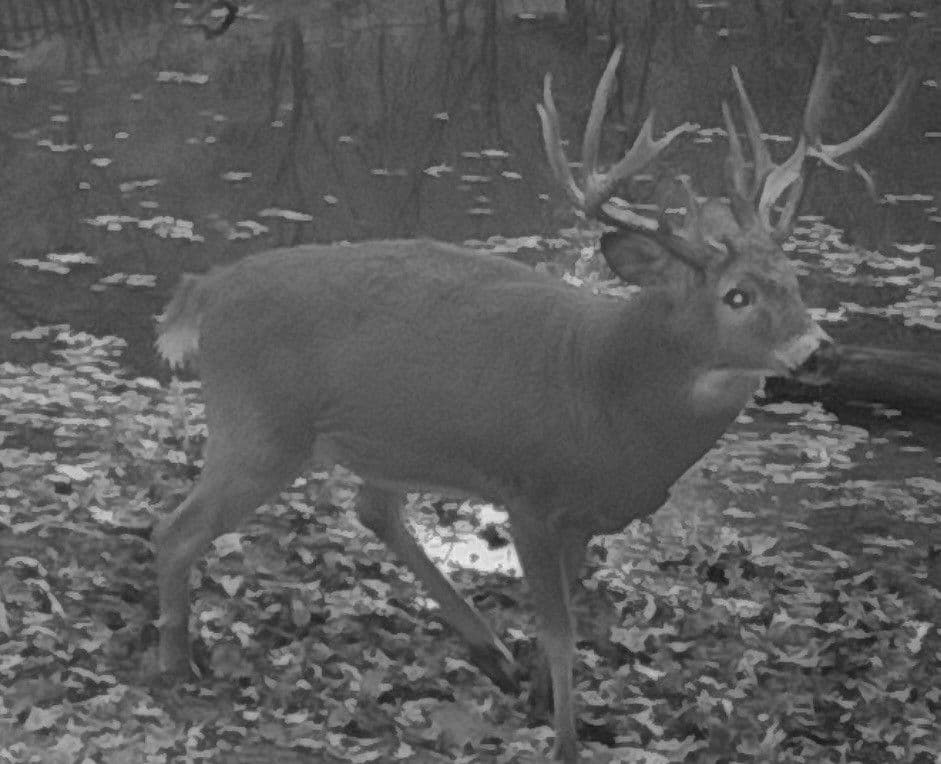Top Gear for DIY Whitetail Deer Hunting: Going Mobile


Justin Hunold
10/04/2024
It’s the season. When hunting whitetail deer, embracing a mobile style can give you an edge, especially on public or lightly pressured private lands. The ability to pack up and move when conditions change is crucial. In this guide, we’ll break down each piece of gear you need for mobile DIY whitetail deer hunting, focusing on portability, versatility, and efficiency.

Tree Stands: Lightweight and Portable
For the mobile hunter, tree stands must be easy to carry and set up without sacrificing comfort or functionality.
- Hang-On Tree Stands: Hang-on stands like the Lone Wolf Custome Gear, The Hunting Beast Stand or XOP Vanish are popular for a reason. They weigh 10-14 pounds, making them light enough to carry into the woods on your back. The compact design allows you to find more trees that work for your setup. Pairing a hang-on stand with climbing sticks, such as Hawk Helium or Novix sticks, means you can easily reach heights of 15-20 feet, giving you the elevation you need for a proper shot and scent control. Their main advantage lies in versatility—they work on almost any tree, unlike climbers, which are limited by tree shape.
- Climbing Stands: Climbing stands, like the Summit Viper SD, offer convenience and comfort. While they can be slightly bulkier to carry than hang-on stands, they have an integrated climbing mechanism that eliminates the need for climbing sticks. The Summit Viper SD, for example, is lightweight (around 20 pounds) and provides a padded seat for those long sits. Its most significant limitation is that it requires straight, branchless trees, so it’s less versatile than a hang-on.
Tree Saddles: Ultimate Mobility
Tree saddles are the cutting edge of mobile whitetail deer hunting. If you're hunting public land or moving frequently, saddles are the ultimate solution for minimizing weight and maximizing adaptability.
- Popular Saddles: Saddles like the Trophyline Venatic or Nimbus are designed to be ultra-light, with many setups weighing less than 5 pounds, including your platform. Saddles allow you to climb and hunt from nearly any tree, even those with crooked trunks or lots of branches. They also offer 360-degree shooting lanes, something most stands can’t match. The compact size of a saddle and platform lets you carry everything you need in a small pack, leaving your hands free for a bow or rifle.
- Advantages of Saddle Hunting: The most significant advantage of saddle hunting is mobility. You can climb and hunt from virtually any tree, giving you access to spots where traditional stands don’t work. Additionally, they’re much quieter to set up and take down, which helps minimize pressure on the deer herd. With a saddle, you can adjust your shooting position by pivoting around the tree, allowing for better concealment and more shot opportunities.
Clothing: Layering for Comfort and Stealth
In mobile hunting, managing your body temperature and staying quiet are essential. This is where layering comes in—you need to be able to adjust to changing conditions throughout the day while keeping your movement silent.
- Base Layers: Start with a moisture-wicking base layer, like merino wool. Merino wool is ideal for mobile hunting because it’s breathable, helps regulate body temperature, and controls odor. Brands like Code Of Silence offer merino wool options that keep you comfortable during high-effort hikes and insulate when sitting still—staying scent-free while on the move is critical to not alerting nearby deer.
- Insulating Layers: Your insulating layer depends on the weather. In the early season, a light fleece or puffy jacket may be enough to trap warmth without overheating. Opt for packable insulation like the KUIU Super Down or Sitka Kelvin Active in colder weather. These lightweight jackets pack small, so they won’t take up much space in your backpack.
- Outer Layers: The outer layer needs to be both weather-resistant and quiet. Soft-shell jackets like the Sitka Stratus or First Lite Catalyst offer wind and water resistance without the noisy crinkle you get from cheaper rain gear. In the mobile hunting game, silence is golden, and these soft shells keep you warm and dry while allowing stealthy movement.
Footwear: Silent and Comfortable
Footwear is critical for covering the ground. Mobile hunters often walk miles to find the perfect setup, and they need boots that keep them comfortable while remaining quiet.
- Lightweight Boots: A pair of lightweight hunting boots will save you from fatigue when walking long distances or through rough terrain. The LaCrosse Alphaburly Pro is a favorite for whitetail hunters, providing waterproofing, insulation, and comfort. For a more versatile boot, the Crispi Summit GTX is highly regarded for its support and breathability, making it ideal for more active hunts.
- Rubber Boots for Scent Control: Rubber boots are excellent for keeping your scent down if you’re hunting near water or in swampy areas. Whitetails have an incredible sense of smell, and rubber boots like the Muck Boot Fieldblazer II help contain scent while protecting your feet in wet conditions.
Backpacks: Efficient Gear Storage
Carrying your gear efficiently is crucial for mobile hunting. You’ll need a pack to hold your stand or saddle setup, climbing sticks, layers of clothing, snacks, water, and hunting tools like rangefinders and calls.
- Top Packs: For mobile whitetail deer hunters, a sound pack should be lightweight, comfortable, and able to carry all your essentials without weighing you down. The Mystery Ranch Pop-Up 38 is an excellent choice. It has enough capacity to haul your saddle setup, layers, and gear, with a pop-up frame that provides extra support when carrying heavier loads. The ALPS OutdoorZ Pursuit pack is another great option, offering dedicated pockets for calls, a quiver, and a hydration bladder.

Miscellaneous Must-Have Gear
Mobile hunting requires being prepared for a range of scenarios. Here are a few smaller but essential gear items that will help you stay efficient and effective.
- Rangefinder: A compact rangefinder like the Vortex Ranger 1800 or Leupold RX-1600i TBR/W is crucial for quickly determining yardage. This becomes especially important when you’re constantly changing setups in new areas where you may not be familiar with the terrain or distances.
- Mobile Hunting App: Apps like OnX Hunt or Spartan Forge are invaluable tools for mobile hunters. These apps allow you to access satellite maps, track your route, mark your stands, and even identify public/private land boundaries. The ability to scout and adjust your location on the go can drastically improve your success rate.
- Scent Control: As a mobile hunter, you’ll be moving through many different environments, so scent control is critical. Consider bringing a small bottle of scent eliminator spray before and during your hunt. Additionally, ozone bags like the ScentLok OZ bags help keep your gear scent-free between hunts.
- Bow/Gun Hangers: A reliable bow or gun hanger can make your seat more comfortable when you're in the tree. Compact hangers like the Hawk Hookster or the HME Bow Hanger are lightweight and easy to pack but strong enough to keep your weapon within reach without getting in your way.
Conclusion: Gear Up and Stay Mobile
Mobile whitetail deer hunting is all about preparation and flexibility. The right gear ensures you can move with the deer and adjust your strategy on the fly. From lightweight stands and saddles to layered clothing, efficient backpacks, and the proper footwear, each piece of gear helps maximize mobility and comfort. With the appropriate setup, you can cover more ground, stay light on your feet, and capitalize on changing conditions in the field.
This season, invest in mobile gear that fits your style of hunting, and you’ll be better equipped to find success on both public and private land. Whether scaling ridges, traversing fields, or sneaking into timber stands, the right gear will make your DIY whitetail deer hunt more productive and enjoyable.
Planning a DIY Whitetail Deer Hunting Trip: Lodging, Meals, and Logistics
A DIY whitetail deer hunting trip can be one of the most rewarding experiences for a hunter, but it requires careful planning, especially when going out of state. The freedom of a DIY hunt allows you to explore new territory, adjust on the fly, and experience whitetail hunting at its purest. However, many logistics must be sorted to ensure your trip goes smoothly. From finding the right lodging option to meal prepping and handling gear transport, a well-thought-out plan will make your hunt more efficient and enjoyable. Let’s dive into the details of planning your next DIY whitetail deer hunting adventure.
Lodging Options for DIY Whitetail Deer Hunts
The lodging you choose will depend on the area you're hunting in, your budget, and the level of comfort you desire. Each option has pros and cons, so consider what works best for your trip.
Airbnb Rentals: A Comfortable Home BaseAirbnb is an increasingly popular option for hunters looking for a comfortable stay without the rigidity of a hotel. Airbnb offers a range of lodging choices, from cabins in rural areas to homes near hunting zones, allowing you to pick a location that keeps you close to your hunting grounds.
- Pros: Airbnb rentals often provide more amenities than traditional hotels, including full kitchens, laundry facilities, and ample space for gear. This makes meal-prepping and gear organization much more accessible. Staying in a rural home also allows you to experience a bit of the local culture and gives you more flexibility with check-in/check-out times.
- Cons: Costs can be higher than other lodging options, especially during hunting season in popular areas. Additionally, you’ll need to verify the property’s proximity to your hunting spot and ensure it allows for an on-site processing game.
- Tips: Look for properties with a garage or shed where you can hang and field-dress a deer, and consider sharing the Airbnb with hunting buddies to split costs.
Camping: Immersed in the HuntIf you want an authentic back-to-nature experience, camping can be an affordable and convenient lodging choice. Whether you set up a tent at a state park or reserve a spot at a campground, camping keeps you close to the action, especially in areas with significant public land.
- Pros: Camping allows you to be in the thick of hunting country, minimizing drive time. It's also one of the most budget-friendly options, especially if you already have camping gear. You can cook meals over the fire, sleep under the stars, and disconnect from modern conveniences.
- Cons: Camping can be physically demanding, especially during cold or wet weather. Without electricity, you'll need to rely on portable power to charge electronics, and managing food and water requires more effort than staying in a rental or hotel. Noise from fellow campers in nearby sites can also be a disturbance.
- Tips: If you're camping in colder months, invest in a high-quality tent and sleeping system to stay warm. If you plan to stay longer, opt for a campsite with facilities like showers and potable water. Keep your food in airtight containers to avoid attracting wildlife near your camp.
Truck Camping: Maximum MobilityTruck camping is an ideal option for hunters who want to stay mobile. With a pickup truck, camper shell, or rooftop tent, you can set up camp legally anywhere you can park. Truck camping allows you to move your camp quickly if the deer change patterns or if you decide to switch hunting spots mid-trip.
- Pros: The mobility of truck camping allows you to follow the action wherever it leads, whether on public or leased private land. Truck campers are more comfortable than tents in bad weather and offer better protection for your gear. You also can park near trailheads or remote areas that traditional campers can’t access.
- Cons: Space is limited, and staying organized in a truck camper can be challenging, especially when managing hunting gear and food. You must also be mindful of local laws regarding overnight parking on public lands.
- Tips: Install a bed platform to elevate your sleeping area and create storage. Use a portable stove for easy meal prep, and invest in a power inverter to keep electronics charged. For comfort, add foam mattresses or inflatable pads to create a cozy sleeping setup.
Hotel Rentals: Convenience and ComfortIf you're looking for convenience and modern comforts, staying in a hotel is a reliable option. Hotels in small towns near popular hunting zones can provide a clean, warm place to rest after a long day in the woods.
- Pros: Hotels offer a comfortable bed, warm showers, and sometimes complimentary breakfasts, saving morning time. Many hotels have laundry facilities, which is excellent for long hunts when you need fresh clothes. They're also located in or near towns, so restocking supplies or grabbing a meal from a restaurant is easy.
- Cons: Hotels can be pricey, especially during hunting season. You’ll also have less space for gear, and some hotels may not be accommodating when it comes to cleaning or storing games.
- Tips: Call ahead to confirm the hotel’s policies regarding hunting gear and game processing. Many smaller, locally-owned hotels in hunting areas are more flexible than chain hotels. You can also request a ground-floor room to make loading and unloading gear easier.

Meal Prepping and Food Planning for DIY Whitetail Hunts
When you're out in the woods for long hours, what and how you eat can make a big difference in your stamina and focus. Planning your meals beforehand ensures you're focused on finding food or settling for unhealthy gas station snacks. Whether camping, staying at an Airbnb, or in a hotel, meal prepping is essential to your logistics.
Meal Prepping for Airbnb and Camping:
- Prep at Home: Before you leave, prepare meals that can be frozen and reheated easily. Chili, stews, casseroles, and grilled meats are all excellent choices that can be made in bulk, frozen in individual portions, and stored in coolers. For camping, consider foil-packet meals that can be cooked over the fire.
- Breakfast: Quick and easy breakfast options are essential for early mornings. Overnight oats, pre-made breakfast burritos, or protein bars can fuel you before you hit the woods. If you can access a stove or grill, bacon and eggs are always a solid choice.
- Snacks: Pack calorie-dense snacks like trail mix, jerky, protein bars, and fruit to keep in your pack during the hunt. These will keep your energy levels up without needing a complete meal in the field.
- Dinners: After a long day, you’ll want something hearty but easy. Reheating pre-cooked meals, grilling venison (if you're lucky enough to harvest it), or cooking simple pasta dishes can be quick and satisfying options.
Truck Camping or Hotel Food Plans:
- Portable Stoves: If you're truck camping or staying in a hotel without a kitchen, bring a portable stove or grill to cook simple meals. Camp stoves like the Jetboil Flash or Coleman portable stoves are great for boiling water quickly or heating pre-made meals.
- Hotel Room Cooking: You may not have access to full cooking facilities in a hotel, but a small plug-in cooler and a microwave can get the job done. Stock up on easy-to-make foods like instant noodles, microwaveable rice packets, and canned soups that don’t require a full kitchen.
- Grocery Store Stops: If you’re staying in a hotel, plan to make a few grocery store stops throughout the trip for fresh food and snacks. Keeping a cooler in your truck with sandwich supplies, fruits, and drinks is an excellent way to avoid fast food while keeping your meals affordable and healthy.
Other Logistics to Consider for Out-of-State Hunts
Licensing and Regulations: Ensure you have the proper hunting licenses and tags for the state you’ll be hunting. Some states require specific permits for public land access, and there may be restrictions on what gear you can use in certain areas. Be sure to familiarize yourself with local hunting regulations and season dates before planning your trip.
Gear and Travel: For out-of-state trips, it’s essential to have a checklist for all your hunting gear. Make sure everything is packed and organized before you leave, whether it’s your bow, rifle, clothing, stands, or saddles. If you’re flying to your destination, check airline regulations for transporting firearms and hunting equipment. Invest in durable, lockable cases for your gear.
Emergency Plan: Always have an emergency plan when hunting in unfamiliar territory. Share your hunting location and schedule with someone back home, carry a GPS or a reliable mapping app like OnX, and pack a small first aid kit.
Conclusion: Plan for a Successful DIY Whitetail Hunt
Planning a successful DIY whitetail deer hunting trip requires more than just picking a spot and heading into the woods. From lodging to food prep and the logistics of transporting gear, taking the time to prepare every detail can make your hunt smoother and more enjoyable. Whether you camp, truck camp, stay in a hotel, or rent an Airbnb, tailoring your plans to your needs will ensure you’re well-rested, well-fed, and ready to focus on what matters most—tagging that buck of a lifetime.